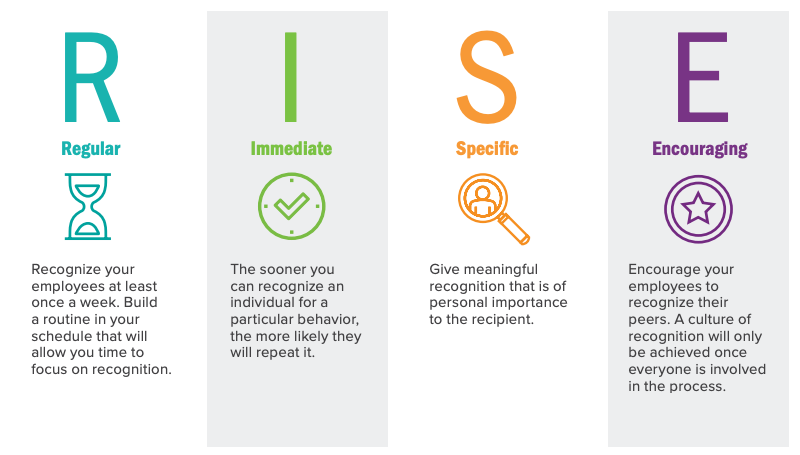Create a culture that means business™
Email address
Competition for top talent is intense, and your highly skilled workers are constantly being wooed by recruiters from other organizations. To build a strong company culture and foster employee engagement and alignment, you need to recognize their contributions in a way that makes them feel genuinely appreciated. The acronym R.I.S.E. is a helpful way to summarize these four employee recognition programs best practices:
R: Regular
People should recognize their colleagues on a consistent basis. Consistently offering appreciation for good performance sets up a reliable feedback system, developing an automatic expectation of excellence in your organization.
I: Immediate
To best reinforce behavior, recognitions should be given in a timely way. It’s a basic truism of psychology that people learn fastest when they receive prompt responses as a result of their actions. This principle is especially relevant when you have younger employees, because millennials have grown up in the fast-paced digital era and have come to expect immediate interactions with their world.
S: Specific
Recognitions should name exactly what the person did that impressed you or that reflected company values. Random or overly general words of praise can actually backfire on you and sound hollow to your workers. As Meghan Biro writes in Forbes, “Recognition should match effort and results, or it loses meaning.”
E: Encouraging
Recognitions should provide positive encouragement. This statement may sound obvious at first, but it refers to the fact that each employee should receive recognition in the form that they find most personally meaningful. In their NYTimes bestselling book, The 5 Languages for Appreciation in the Workplace, authors Gary Chapman and Paul White identify different approaches to employee appreciation. These include words of affirmation and tangible gifts. The authors point out that these methods are all similar to the ways in which parents instill a sense of value in children, although the employer-employee relationship is very different from a parental one.

Start implementing employee recognition programs best practices
With these four employee recognition programs best practices, and the right employee recognition software, you’re well-equipped to build a culture of recognition. The need for appreciation is fundamental to every human being. When this need is understood and fulfilled in a workplace context, it creates a positive environment in which employees feel motivated to excel.
To learn more employee recognition programs best practices, access Achievers’ webinar recording, “Recognition That Works: Driving Amazing Engagement and Boosting ROI.”



